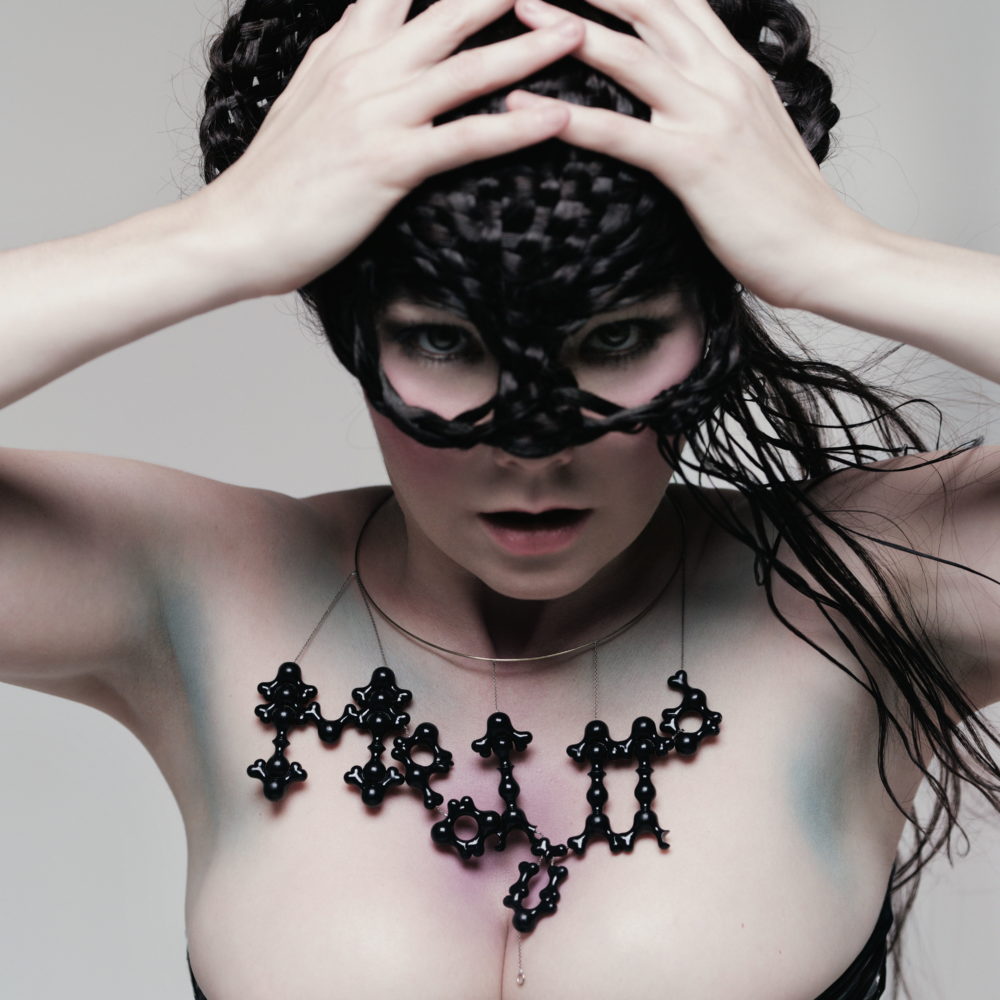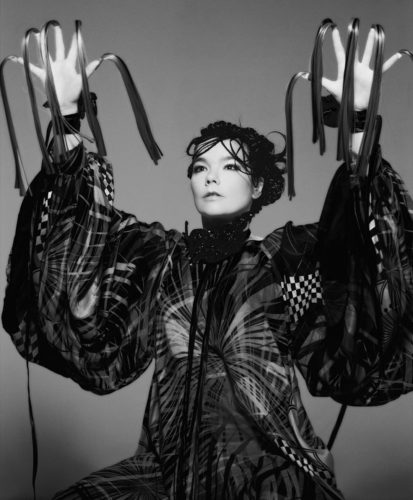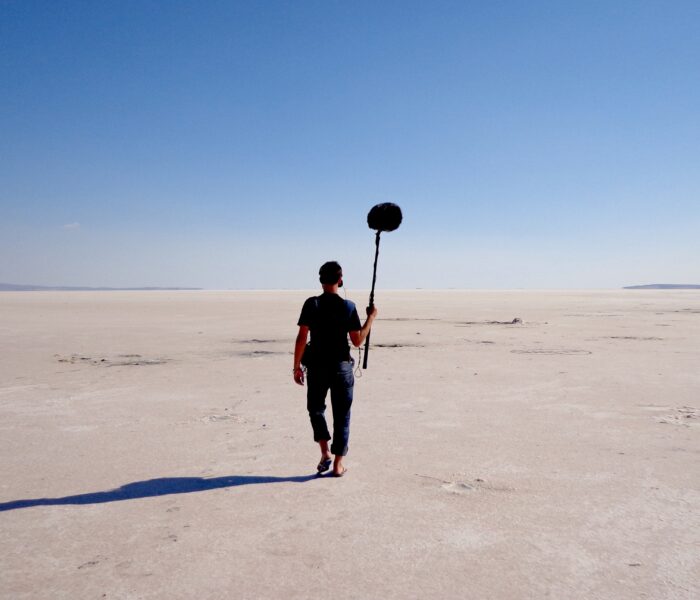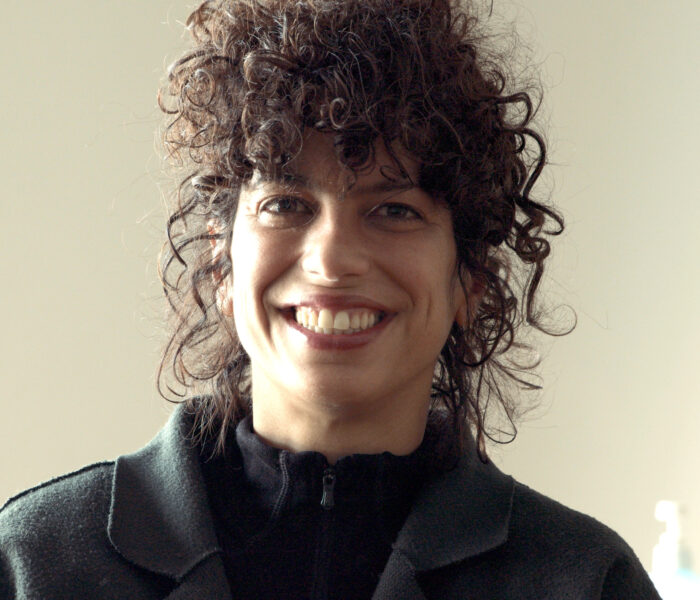Chanteuse, compositrice et musicienne, Björk Guðmundsdóttir (1965, Reykjavik) s’éveille à la musique dans une communauté hippie où sa mère, militante féministe s’est installée. Inscrite à la Barnamúsíkskóli de Reykjavik à l’âge de cinq ans, elle y apprend la flûte traversière, le piano, la théorie musicale et l’histoire de la musique. Elle chante dans différentes chorales et s’intéresse au jazz, s’ouvre à la musique contemporaine de Messiaen, Cage et Stockhausen, pour lequel elle garde une profonde admiration, tout en étant bercée par l’héritage musical folklorique transmis par ses deux grand-mères islandaises.
Dès 1981, Björk chante au sein de différents groupes punks dont KUKL (« magie noire »), fondé en 1983, puis, en 1986 dans une nouvelle formation au style pop/new wave, The Sugarcubes, dont la renommée grandit au Royaume-Uni.
Après la séparation des Sugarcubes en 1992, elle s’installe en Angleterre et enregistre en 1993 son premier album avec l’aide de Nellee Hooper, Debut, dans un style pop électronique nourri des influences de Kraftwerk et Brian Eno et teinté de house music, techno, musiques du monde et jazz. C’est un succès.
Elle multiplie dès lors les collaborations fructueuses : Graham Massey, Talvin Singh, Tricky, Zeena Parkins, Antony etc. Michel Gondry réalise huit clips pour elle. Les disques Post (1995) et Homogenic (1997) perfectionnent son style baroque et affinent sa voix exceptionnelle, mélange subtil de fragilité, spontanéité, technicité et virtuosité.
Le chef Kent Nagano l’invite à chanter Pierrot lunaire de Schönberg au Verbier Festival (Suisse) en 1996. En 1998, alors qu’elle retourne vivre en Islande, son esthétique emprunte une nouvelle voie, plus intime et expérimentale. Elle incarne le rôle principal de Selma dans le film Dancer in the Dark de Lars von Trier, dont elle signe aussi la bande originale (2000). L’album Vespertine (2001) est conçu avec le duo Matmos, Matthew Herbert et l’arrangeur Vince Mendoza, qui l’aident à concrétiser des ambitions musicales de plus en plus raffinées.
En 2002, la chanteuse épouse le plasticien Matthew Barney et s’installe à New York.
Elle envisage alors de composer un nouvel album entièrement fondé sur la voix : « Je voulais m’éloigner des instruments et de l’électronique qui faisaient l’univers sonore de Vespertine, mon précédent album. Je veux explorer ce qui peut être fait avec tous les registres émotionnels de la voix humaine – voix solistes, chœur, voix travaillées, voix pop, voix folk, voix bizarres… Et pas seulement dans des mélodies, mais tout le reste, tous les bruits que peut produire un gosier humain. » (Alex Ross, Listen To This, La musique dans tous ses états, p 220)
La plupart des quatorze morceaux qui constituent l’album Medúlla sont composés en 2003 lors d’un voyage à la Gomera, aux îles Canaries. L’enregistrement s’étale ensuite jusqu’à juillet 2004, débutant à Reykjavik au côté du producteur Valgeir Sigurðsson, qui œuvre avec Björk depuis 1998, puis se poursuivant notamment au Salvador, à Londres et à New York. L’artiste a suscité beaucoup de chanteurs pour collaborer à son projet : les chorales The Icelandic Choir et The London Choir, les chanteurs Gregory Purnhagen (baryton classique), Mike Patton (ex-Faith No More), Tanya Tagaq (chant inuit, déjà présente sur Vespertine), Robert Wyatt (ex-Soft Machine); les trois beatboxers1 Dokaka, Shlomo et Rahzel ; auxquels se joignent les musiciens Mark Bell, Leila Arab, Olivier Alary, Peter van Hooke et Nico Muhly. L’univers esthétique de l’artiste new-yorkaise Meredith Monk a beaucoup influencé la couleur de l’album.
Medúlla est le nom scientifique de la moelle. Björk voulait initialement intituler l’album Ink (encre) pour faire référence à « ce sang noir qui coule en chacun de nous depuis cinq mille ans ; un ancien esprit passionnant et sombre ; un esprit qui survit ». (The Independant, 13 août 2014, James McNair “Björk : Passion in a cold climate”)
Ce disque est mystique, spirituel, philosophique mais aussi politique, s’engageant contre le racisme et la violence qui fait suite aux attentats du 11 septembre 2001. Il est aussi habité par la naissance de sa fille Isadóra, en 2002.
La voix y est omniprésente depuis son expression primale la plus charnelle jusqu’au raffinement du traitement informatique. Seuls quelques rares instruments apparaissent çà et là (piano, gong, synthétiseur).
« Pleasure Is All Mine » (1) fait entendre, dès les premières vocalises de Björk, la voix caractéristique de Tagaq, avec ses halètements, ses respirations et ses sons gutturaux propres à la culture inuite, alors que Mike Patton assure des basses profondes que complète la rythmique de Rahzel. Les tenues de The Icelandic Choir offrent un écrin tout en douceur à la voix de la chanteuse qui clame les bienfaits de la générosité.
Enregistré au plus près de l’organe vocal de Björk, son solo a capella « Show Me Forgiveness » (2) suggère l’intimité et la profondeur d’une prière, qui contraste avec les masses et la violence rythmique de « Where Is The Line » (3), dont l’effectif se rapproche du premier morceau. La voix de Rahzel y est samplée, découpée et rythmée, mais jamais transformée, et les basses puissantes de Patton doublent les refrains de Björk, tandis que les chœurs insufflent des harmonies étranges à tout le titre.
« Vökuró » (4, Veille ) est une berceuse de Jórunn Viðar sur un poème de Jakobína Sugardóttir, chantée avec un accompagnement choral subtil. L’intermède « Öll Birtan » (5, Toute la brillance ) met en jeu des boucles superposées d’onomatopées, qui ouvrent sur« Who Is It » (6), en collaboration avec Matmos, et laisse éclater la puissance du beatboxing de Rahzel dans un morceau aux mille bruissements et au refrain ciselé, « une chanson entre la pop et les méditations chorales d’Arvo Pärt ». (Alex Ross, op.cit., p 221)
« Submarine » (7) démultiplie la voix de Robert Wyatt, son chant, ses bruitages, ses respirations, qui se fondent dans des harmonies envoûtantes avec celle de Björk clamant un appel à l’action. Le fond sonore grésillant du méditatif « Desired Constellation » (8) est programmé par Olivier Alary à partir d’un échantillon de la voix de la chanteuse. Cet accompagnement minimaliste donne sa force à la mélodie de Björk qui monte progressivement en intensité. Dans « Oceania » (9), The London Choir effectue des glissandi dynamiques ascendants et descendants mis à l’envers, soutenus par la rythmique énergique de Shlomo et les samples vocaux de Robert Wyatt. Björk chante ce morceau lors de la cérémonie d’ouverture des Jeux Olympiques d’Athènes le 13 août 2004, peu avant la sortie de l’album.
« Sonnets / Unrealities XI » (10) se base sur un poème de E. E. Cummings, tandis que « Ancestors » (11) est une joute vocale fascinante entre Björk et Tagaq soutenue par un piano discret. La fin de « Mouth’s Cradle » (12) renvoie dos à dos à leurs responsabilités Oussama Ben Laden et George W. Bush. Ce titre repose sur des bribes de voix samplées et une grande richesse chorale : « Ce que je veux, c’est un côté païen et aussi quelque chose de slave. ». (Alex Ross, op.cit., p 222)
La transition « Miðvikudags » (13, Mercredi) est un écho de « Öll Birtan » préparant à « Triumph Of A Heart » (14), chanson pop à la gloire du corps humain qui révèle le talent vocal de Dokaka dans une rythmique endiablée secondée par Rahzel.
Mark “Spike” Stent assure le mixage et la production finale de l’album, sorti le 30 août 2004 au Royaume-Uni. L’étendue des moyens et le confort de création d’une artiste au statut de star peuvent laisser rêveur. Ils permettent la réalisation d’une œuvre collective, rappelant l’image de l’atelier d’artiste ou encore le travail des Beatles, depuis la conception des morceaux jusqu’aux vidéo-clips raffinés (Spike Jonze, Gabriela Fridriksdóttir…). Les multiples compétences rassemblées sont orchestrées par le talent de Björk au service de sa vision artistique. Elle embrasse les possibilités de la réalité virtuelle et de l’interactivité (exposition « Björk Digital », 2016).
Son originalité et son monde intérieur continuent de s’exprimer à travers tous les albums suivants, transcendant toujours plus les catégories musicales populaire, savante, expérimentale ou folklorique.
Guillaume Kosmicki
Tiré de “Musique savantes, De John Zorn à la fin du monde et après…” 1990-2015 aux éditions Le mot et le reste
1. Le human beatbox ou tout simplement beatbox est une technique vocale apparue avec la culture hip-hop dans les années soixante-dix, dans laquelle le chanteur imite les sons d’une batterie ou d’une boîte à rythmes avec sa voix, mais aussi de toutes sortes d’autres instruments.
A écouter aussi :



)





